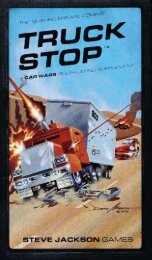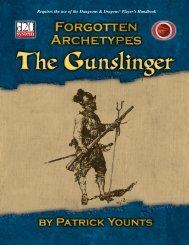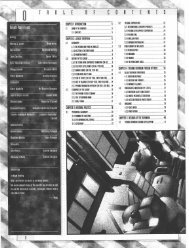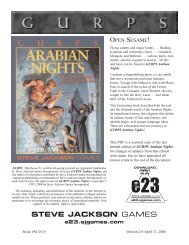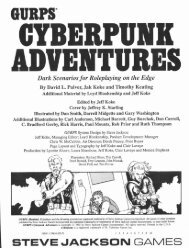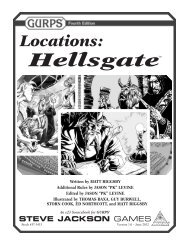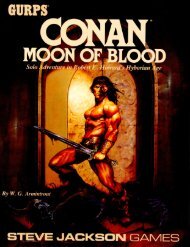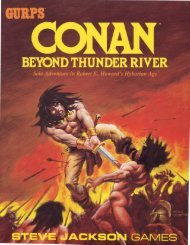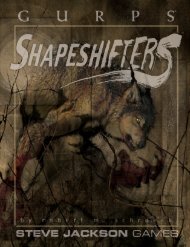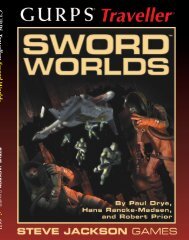Create successful ePaper yourself
Turn your PDF publications into a flip-book with our unique Google optimized e-Paper software.
About L. Sprague de Camp<br />
L. Sprague de Camp is a major figure<br />
in modem American fantasy and science<br />
fiction. He began publishing in the Golden<br />
Age of John Campbell's Astounding and<br />
Unknown and has been at it since. He has<br />
written science fiction, fantasy, historical<br />
fiction and non-fiction (including<br />
biographies of H. P. Lovecraft and Robert<br />
E. Howard).<br />
Map of Hyboria<br />
On pp. 36-37 is a map of the world of<br />
Hyboria. This map is based, first and<br />
foremost, on the sketches drawn by Robert<br />
E. Howard himself. Before the first Conan<br />
story was published, he obviously had a<br />
clear idea of the "lay of the land" over<br />
much of Hyboria.<br />
Other areas, however, were left vague<br />
(perhaps purposely) by Howard, and it has<br />
fallen to his students to fill them in. For<br />
those areas, the present maps are based on<br />
a variety of sources, but most of all on the<br />
text descriptions in the tales themselves.<br />
Conan The Mighty — 4 —<br />
Robert Howard, alas, achieved no Conanian triumph. Howard lived most of<br />
his life in Cross Plains, a town of 1,500 in central Texas. This was as unpropitious<br />
a setting for a writing career as could be found. Save for a couple of<br />
helpful English teachers in high school, he was entirely self-taught.<br />
Howard resolved upon a writing career while still a boy and plunged into it<br />
as soon as he finished high school. His first sale came in 1924 to the magazine<br />
Weird Tales which, of the many publications he contributed to, remained his best<br />
single outlet.<br />
By 1928, he had mastered his craft and thereafter sold regularly to the pulp<br />
magazines. He sold boxing stories, detective stories, horror stories, tales of<br />
historical and oriental adventure, Westerns, science fiction, fantasy and verse.<br />
He earned around $2,000 a year from his writing, which by the standards of the<br />
1930s was quite a fair living — though the townsfolk wondered when he was<br />
going to give up writing silly stories and settle down to a proper job in a local<br />
shop or in the oil fields.<br />
A great natural storyteller, Howard developed a distinctive prose style,<br />
using such poetic elements as rhythm, alliteration and personification. In the late<br />
1920s, he specialized in boxing stories, in the early '30s in fantasy, and in the<br />
middle '30s in Westerns, although he wrote stories of all these types throughout<br />
his career.<br />
Howard began the Conan stories, upon which his posthumous revival is<br />
based, in 1932. Conan is an idealization of what Howard thought he would like<br />
to have been: a footloose, lawless, hell-raising, irresponsible adventurer devoted<br />
to wine, women and violence. But, save for a big, powerful physique, a hot<br />
temper, and a chivalrous attitude toward women, Howard and Conan had nothing<br />
in common. Howard was shy, sensitive, upright, law-abiding, courteous,<br />
compassionate, reclusive, introverted, bookish and (though he denied it) intellectual.<br />
He did not attribute such qualities to Conan.<br />
Howard suffered from isolation, minimal worldly experience, limited travel<br />
outside of Texas and a lack of access to big-city and university libraries. An even<br />
greater handicap was his family situation. Howard was excessively attached to<br />
his mother, who encouraged his slavish devotion. As a boy he resolved not to<br />
outlive her. In June 1936, after a long illness, his mother lay unconscious, dying<br />
of tuberculosis. Howard, aged thirty, with a growing circle of admirers, an<br />
adequate if not lavish income, and a promising career before him, shot himself.<br />
In his lifetime, Robert Howard sold over 160 stories and left 100-odd unfinished<br />
or unsold. For 20 years after his death, his Conan tales remained the<br />
private enthusiasm of a small circle of connoisseurs. In the 1950s, an obscure<br />
publisher began publishing the Conan stories in small hard-cover editions; but it<br />
was their appearance in a unified paperback series, beginning in 1966, that set in<br />
motion Conan's current popularity.<br />
Indeed, this paperback series, together with the simultaneous paperback<br />
publication of J.R.R. Tolkien's three-volume The Lord of the Rings, touched off<br />
today's enormous revival of fantasy. The present writer, who was mainly<br />
responsible for the paperback Conans, also with the help of collaborators, added<br />
numerous stories to the saga, following Howard's original plan, style and spirit<br />
as closely as possible.<br />
For over a decade, Conan Properties, Inc., has controlled all rights to the<br />
giant barbarian and divides the profits from the use of the character among the<br />
Howard heirs and the living writers. Conan has appeared in countless collections<br />
and anthologies, comic books and motion pictures — although, ironically,<br />
Howard's literary rights were given no value at all in appraising his estate. Conan<br />
Properties chooses experienced contemporary writers to continue the adventures<br />
of the mighty barbarian.<br />
— L. Sprague de Camp




